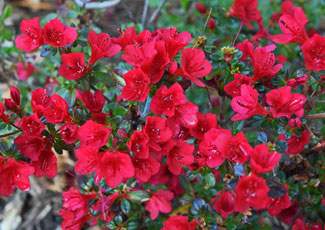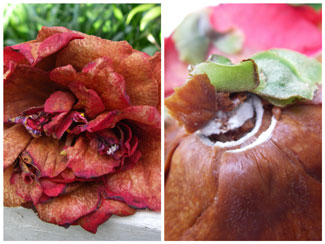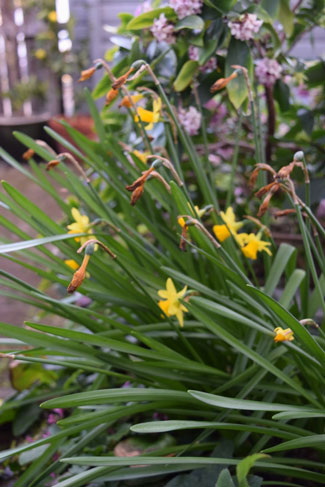Camellia time
September 2014
Spring is hard to ignore now that it’s September. After what was in my area, a fairly wet and cold August the sun now shines higher and the lighter mornings make it easier to rise (just wait until daylight saving kicks in!). In the garden, the Hellebores are in full flower, Azalea Ward’s Ruby has been flowering all winter and continues to glow, and my only Camellia “Nicky Crisp” is blooming.
Camellias are a favourite of mine – with careful choice of varieties they provide colour from autumn through to early summer. They can be used in the garden for height and structure, as hedges for background and framing, as topiary for formality and even espaliered against a wall. The flowers may be exquisitely tiny, perfectly formal or gushingly flouncy; some are scented and the large open flowers are a great source of pollen for bees.
Camellias require little fuss – free draining and slightly acidic soil, out of harsh sun and winds, fed once a year with acid fertiliser and the occasional trim to either shape or thin. In the large garden that lives in my head, I have hedges of clipped “Setsugekka” (single white fragrant) and large shrubs of “Nicky Crisp” (semi-double shell pink) and “Maroon & Gold” (double dark red with golden stamens).
The flowers are however, susceptible to Petal Blight, a serious fungal disease that arrived in New Zealand in the 1990s. The ‘fruit’ of the fungus lives in the soil and in spring releases spores into the air. These spores require the petals to be wet to infect, which may be why petal blight is appearing earlier this year after a wet August. Infected flowers develop ugly brown blotches which quickly spread into the base of the flower, causing the flowers to fall early. To check for the presence of petal blight, look under the calyx for a tell-tale ring of white.
Clean up infected blossoms from the ground and the tree (give it a shake) and get rid of them, but do not put them in the compost pile! The fungi will continue to survive in the compost and could be spread to new uninfected areas. Cover the soil beneath the plants with 10cms of organic mulch to reduce spore survival. By eliminating or reducing the amount of fungal spores that are released into the air, the chance of infection is dramatically reduced.
I’m keeping a close eye on two of my hydrangeas. They are growing in soil that is obviously alkaline (the blue hydrangea flowered pink in its first year!) but I am keen to have blue or even purple flowers. At the first signs of flower buds, I will drench each plant with a solution of aluminium sulphate, ¼ cup dissolved in 10 litres of water, which I have read will change their colour. Only time will tell.
My little ‘Tete-a-tete’ daffodils have all but finished flowering. A quick nip of the spent flower heads will save the bulbs the energy of producing seed and a feed of bulb fertiliser (high in potassium) will help the bulbs set flowers for next year.
14-Sep-2014

Azalea Ward's Ruby

Camellia Setsugekka

Camellia petal blight

Dead head daffodils

